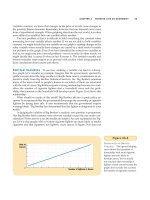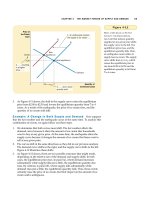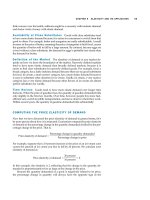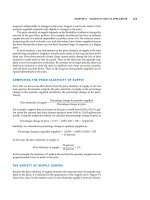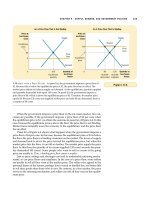Tài liệu Ten Principles of Economics - Part 72 docx
Bạn đang xem bản rút gọn của tài liệu. Xem và tải ngay bản đầy đủ của tài liệu tại đây (234.85 KB, 10 trang )
CHAPTER 32 THE INFLUENCE OF MONETARY AND FISCAL POLICY ON AGGREGATE DEMAND 735
holdings are a small part of household wealth, the wealth effect is the least impor-
tant of the three. In addition, because exports and imports represent only a small
fraction of U.S. GDP, the exchange-rate effect is not very large for the U.S. econ-
omy. (This effect is much more important for smaller countries because smaller
countries typically export and import a higher fraction of their GDP.) For the U.S.
economy, the most important reason for the downward slope of the aggregate-demand
curve is the interest-rate effect.
To understand how policy influences aggregate demand, therefore, we exam-
ine the interest-rate effect in more detail. Here we develop a theory of how the in-
terest rate is determined, called the theory of liquidity preference. After we
develop this theory, we use it to understand the downward slope of the aggregate-
demand curve and how monetary policy shifts this curve. By shedding new light
on the aggregate-demand curve, the theory of liquidity preference expands our
understanding of short-run economic fluctuations.
THE THEORY OF LIQUIDITY PREFERENCE
In his classic book, The General Theory of Employment, Interest, and Money, John
Maynard Keynes proposed the theory of liquidity preference to explain what fac-
tors determine the economy’s interest rate. The theory is, in essence, just an appli-
cation of supply and demand. According to Keynes, the interest rate adjusts to
balance the supply and demand for money.
You may recall from Chapter 23 that economists distinguish between two in-
terest rates: The nominal interest rate is the interest rate as usually reported, and the
real interest rate is the interest rate corrected for the effects of inflation. Which in-
terest rate are we now trying to explain? The answer is both. In the analysis that
follows, we hold constant the expected rate of inflation. (This assumption is rea-
sonable for studying the economy in the short run, as we are now doing). Thus,
when the nominal interest rate rises or falls, the real interest rate that people ex-
pect to earn rises or falls as well. For the rest of this chapter, when we refer to
changes in the interest rate, you should envision the real and nominal interest
rates moving in the same direction.
Let’s now develop the theory of liquidity preference by considering the sup-
ply and demand for money and how each depends on the interest rate.
Money Supply
The first piece of the theory of liquidity preference is the sup-
ply of money. As we first discussed in Chapter 27, the money supply in the U.S.
economy is controlled by the Federal Reserve. The Fed alters the money supply
primarily by changing the quantity of reserves in the banking system through the
purchase and sale of government bonds in open-market operations. When the Fed
buys government bonds, the dollars it pays for the bonds are typically deposited
in banks, and these dollars are added to bank reserves. When the Fed sells gov-
ernment bonds, the dollars it receives for the bonds are withdrawn from the bank-
ing system, and bank reserves fall. These changes in bank reserves, in turn, lead to
changes in banks’ ability to make loans and create money. In addition to these
open-market operations, the Fed can alter the money supply by changing reserve
requirements (the amount of reserves banks must hold against deposits) or the
discount rate (the interest rate at which banks can borrow reserves from the Fed).
theory of liquidity
preference
Keynes’s theory that the interest rate
adjusts to bring money supply and
money demand into balance
736 PART TWELVE SHORT-RUN ECONOMIC FLUCTUATIONS
These details of monetary control are important for the implementation of Fed
policy, but they are not crucial in this chapter. Our goal here is to examine how
changes in the money supply affect the aggregate demand for goods and services.
For this purpose, we can ignore the details of how Fed policy is implemented and
simply assume that the Fed controls the money supply directly. In other words, the
quantity of money supplied in the economy is fixed at whatever level the Fed
decides to set it.
Because the quantity of money supplied is fixed by Fed policy, it does not de-
pend on other economic variables. In particular, it does not depend on the interest
rate. Once the Fed has made its policy decision, the quantity of money supplied is
the same, regardless of the prevailing interest rate. We represent a fixed money
supply with a vertical supply curve, as in Figure 32-1.
Money Demand
The second piece of the theory of liquidity preference is the
demand for money. As a starting point for understanding money demand, recall
that any asset’s liquidity refers to the ease with which that asset is converted into
the economy’s medium of exchange. Money is the economy’s medium of ex-
change, so it is by definition the most liquid asset available. The liquidity of money
explains the demand for it: People choose to hold money instead of other assets
that offer higher rates of return because money can be used to buy goods and ser-
vices.
Although many factors determine the quantity of money demanded, the one
emphasized by the theory of liquidity preference is the interest rate. The reason is
that the interest rate is the opportunity cost of holding money. That is, when you
hold wealth as cash in your wallet, instead of as an interest-bearing bond, you lose
the interest you could have earned. An increase in the interest rate raises the cost
of holding money and, as a result, reduces the quantity of money demanded. A de-
crease in the interest rate reduces the cost of holding money and raises the quan-
tity demanded. Thus, as shown in Figure 32-1, the money-demand curve slopes
downward.
Quantity of
Money
Interest
Rate
Equilibrium
interest
rate
0
Money
demand
Quantity fixed
by the Fed
Money
supply
r
1
r
2
M
d
1
M
d
2
Figure 32-1
E
QUILIBRIUM IN THE
M
ONEY
M
ARKET
. According to
the theory of liquidity preference,
the interest rate adjusts to bring
the quantity of money supplied
and the quantity of money
demanded into balance. If the
interest rate is above the
equilibrium level (such as at r
1
),
the quantity of money people
want to hold (M
d
1
) is less than the
quantity the Fed has created, and
this surplus of money puts
downward pressure on the
interest rate. Conversely, if the
interest rate is below the
equilibrium level (such as at r
2
),
the quantity of money people
want to hold (M
d
2
) is greater than
the quantity the Fed has created,
and this shortage of money puts
upward pressure on the interest
rate. Thus, the forces of supply
and demand in the market for
money push the interest rate
toward the equilibrium interest
rate, at which people are content
holding the quantity of
money the Fed has created.
CHAPTER 32 THE INFLUENCE OF MONETARY AND FISCAL POLICY ON AGGREGATE DEMAND 737
Equilibrium in the Money Market
According to the theory of
liquidity preference, the interest rate adjusts to balance the supply and demand
for money. There is one interest rate, called the equilibrium interest rate, at which
the quantity of money demanded exactly balances the quantity of money sup-
plied. If the interest rate is at any other level, people will try to adjust their portfo-
lios of assets and, as a result, drive the interest rate toward the equilibrium.
For example, suppose that the interest rate is above the equilibrium level,
such as r
1
in Figure 32-1. In this case, the quantity of money that people want
to hold, M
d
1
, is less than the quantity of money that the Fed has supplied. Those
people who are holding the surplus of money will try to get rid of it by buy-
ing interest-bearing bonds or by depositing it in an interest-bearing bank ac-
count. Because bond issuers and banks prefer to pay lower interest rates, they
respond to this surplus of money by lowering the interest rates they offer. As the
interest rate falls, people become more willing to hold money until, at the equilib-
rium interest rate, people are happy to hold exactly the amount of money the Fed
has supplied.
Conversely, at interest rates below the equilibrium level, such as r
2
in Fig-
ure 32-1, the quantity of money that people want to hold, M
d
2
, is greater than the
quantity of money that the Fed has supplied. As a result, people try to increase
their holdings of money by reducing their holdings of bonds and other interest-
bearing assets. As people cut back on their holdings of bonds, bond issuers find
that they have to offer higher interest rates to attract buyers. Thus, the interest rate
rises and approaches the equilibrium level.
THE DOWNWARD SLOPE OF
THE AGGREGATE-DEMAND CURVE
Having seen how the theory of liquidity preference explains the economy’s equi-
librium interest rate, we now consider its implications for the aggregate demand
for goods and services. As a warm-up exercise, let’s begin by using the theory to
reexamine a topic we already understand—the interest-rate effect and the down-
ward slope of the aggregate-demand curve. In particular, suppose that the overall
level of prices in the economy rises. What happens to the interest rate that balances
the supply and demand for money, and how does that change affect the quantity
of goods and services demanded?
As we discussed in Chapter 28, the price level is one determinant of the quan-
tity of money demanded. At higher prices, more money is exchanged every time a
good or service is sold. As a result, people will choose to hold a larger quantity of
money. That is, a higher price level increases the quantity of money demanded
for any given interest rate. Thus, an increase in the price level from P
1
to P
2
shifts
the money-demand curve to the right from MD
1
to MD
2
, as shown in panel (a) of
Figure 32-2.
Notice how this shift in money demand affects the equilibrium in the money
market. For a fixed money supply, the interest rate must rise to balance money
supply and money demand. The higher price level has increased the amount of
money people want to hold and has shifted the money demand curve to the right.
Yet the quantity of money supplied is unchanged, so the interest rate must rise
from r
1
to r
2
to discourage the additional demand.
738 PART TWELVE SHORT-RUN ECONOMIC FLUCTUATIONS
This increase in the interest rate has ramifications not only for the money mar-
ket but also for the quantity of goods and services demanded, as shown in panel
(b). At a higher interest rate, the cost of borrowing and the return to saving are
greater. Fewer households choose to borrow to buy a new house, and those who
do buy smaller houses, so the demand for residential investment falls. Fewer firms
choose to borrow to build new factories and buy new equipment, so business in-
vestment falls. Thus, when the price level rises from P
1
to P
2
, increasing money de-
mand from MD
1
to MD
2
and raising the interest rate from r
1
to r
2
, the quantity of
goods and services demanded falls from Y
1
to Y
2
.
Quantity
of Money
Quantity fixed
by the Fed
0
Interest
Rate
r
2
r
1
Money demand at
price level
P
2
,
MD
2
Money demand at
price level
P
1
,
MD
1
Money
supply
(a) The Money Market
(b) The Aggregate-Demand Curve
3. . . . which
increases the
equilibrium
interest rate . . .
2. . . . increases the
demand for money . . .
Quantity
of Output
0
Price
Level
Aggregate
demand
P
2
Y
2
Y
1
P
1
4. . . . which in turn reduces the quantity
of goods and services demanded.
1. An
increase
in the price
level . . .
Figure 32-2
T
HE
M
ONEY
M
ARKET AND
THE
S
LOPE OF THE
A
GGREGATE
-D
EMAND
C
URVE
.
An increase in the price level
from P
1
to P
2
shifts the money-
demand curve to the right, as in
panel (a). This increase in money
demand causes the interest rate
to rise from r
1
to r
2
. Because
the interest rate is the cost of
borrowing, the increase in the
interest rate reduces the quantity
of goods and services demanded
from Y
1
to Y
2
. This negative
relationship between the price
level and quantity demanded is
represented with a downward-
sloping aggregate-demand curve,
as in panel (b).
CHAPTER 32 THE INFLUENCE OF MONETARY AND FISCAL POLICY ON AGGREGATE DEMAND 739
Hence, this analysis of the interest-rate effect can be summarized in three
steps: (1) A higher price level raises money demand. (2) Higher money demand
leads to a higher interest rate. (3) A higher interest rate reduces the quantity of
goods and services demanded.
Of course, the same logic works in reverse as well: A lower price level reduces
money demand, which leads to a lower interest rate, and this in turn increases the
quantity of goods and services demanded. The end result of this analysis is a neg-
ative relationship between the price level and the quantity of goods and services
demanded, which is illustrated with a downward-sloping aggregate-demand
curve.
At this point, we should pause
and reflect on a seemingly awk-
ward embarrassment of riches.
It might appear as if we now
have two theories for how in-
terest rates are determined.
Chapter 25 said that the inter-
est rate adjusts to balance the
supply and demand for loan-
able funds (that is, national
saving and desired invest-
ment). By contrast, we just es-
tablished here that the interest
rate adjusts to balance the supply and demand for money.
How can we reconcile these two theories?
To answer this question, we must again consider the
differences between the long-run and short-run behavior of
the economy. Three macroeconomic variables are of central
importance: the economy’s output of goods and services,
the interest rate, and the price level. According to the clas-
sical macroeconomic theor y we developed in Chapters 24,
25, and 28, these variables are determined as follows:
1. Output is determined by the supplies of capital and
labor and the available production technology for
turning capital and labor into output. (We call this the
natural rate of output.)
2. For any given level of output, the interest rate adjusts
to balance the supply and demand for loanable funds.
3. The price level adjusts to balance the supply and
demand for money. Changes in the supply of money
lead to proportionate changes in the price level.
These are three of the essential propositions of classical
economic theory. Most economists believe that these
propositions do a good job of describing how the economy
works in the long run.
Yet these propositions do not hold in the shor t run. As
we discussed in the preceding chapter, many prices are
slow to adjust to changes in the money supply; this is re-
flected in a short-run aggregate-supply cur ve that is upward
sloping rather than ver tical. As a result, the overall price
level cannot, by itself, balance the supply and demand for
money in the shor t run. This stickiness of the price level
forces the interest rate to move in order to bring the money
market into equilibrium. These changes in the interest rate,
in turn, affect the aggregate demand for goods and ser-
vices. As aggregate demand fluctuates, the economy’s out-
put of goods and services moves away from the level
determined by factor supplies and technology.
For issues concerning the shor t run, then, it is best to
think about the economy as follows:
1. The price level is stuck at some level (based on
previously formed expectations) and, in the shor t run,
is relatively unresponsive to changing economic
conditions.
2. For any given price level, the interest rate adjusts to
balance the supply and demand for money.
3. The level of output responds to the aggregate demand
for goods and services, which is in part determined by
the interest rate that balances the money market.
Notice that this precisely reverses the order of analysis
used to study the economy in the long run.
Thus, the different theories of the interest rate are use-
ful for different purposes. When thinking about the long-run
determinants of interest rates, it is best to keep in mind the
loanable-funds theory. This approach highlights the impor-
tance of an economy’s saving propensities and investment
opportunities. By contrast, when thinking about the short-
run determinants of interest rates, it is best to keep in mind
the liquidity-preference theory. This theory highlights the im-
portance of monetary policy.
FYI
Interest Rates
in the Long Run
and the
Short Run
